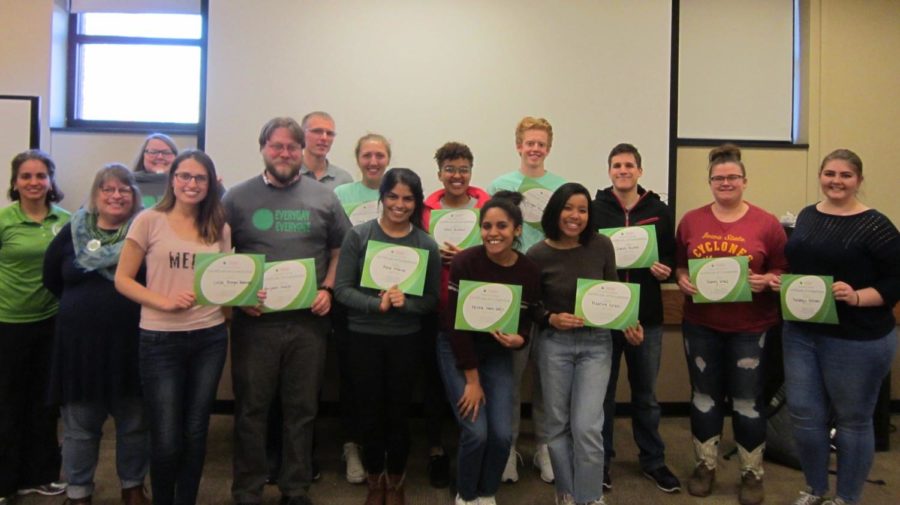Green Dot trains bystanders to be the change
Students who completed the Green Dot bystander training, April 7, stand with their training certificates.
April 7, 2018
With over 36,000 students, Iowa State has a large population to reach when it comes to education on power-based violence, such as sexual assault, stalking and domestic violence.
The implementation of Iowa State’s Green Dot program, focused at preventing and solving violence, is one approach that aims to empower bystanders to act.
As stated in the Green Dot bystander training handout, “No one has to do everything, everyone has to do something.”
The Green Dot program is meant to serve as either a proactive or reactive choice that promotes safety and intolerance of power-based personal violence at Iowa State.
According to the handout, “A green dot is any behavior, choice or action that promotes safety and communicates utter intolerance for violence …. A green dot is simply your individual choice at any given moment to make our campus safer.”
On the other hand, a red dot represents an act of interpersonal violence, including intimidating words, controlling behaviors and unwanted touch.
With a goal to have more green dots than red dots, the training is simply another opportunity for individuals willing to step in to receive education on the behaviors of power-based violence.
On April 7, around 30 students went through five hours of Green Dot bystander training, walking through different scenarios on the process of a bystander.
In a situation where a bystander has the ability to help in a power-based violence event, there are three Green Dot options:
-
Direct
-
Delegate
-
Distract
Direct action involves letting those involved in the red dot know of your concern.
Delegation recognizes the situation as a red dot and moves the bystander to get someone else involved.
Distraction means getting the attention of those involved in the red dot and diverting their attention.
A question Green Dot bystander training asks is: Does the bystander hold responsibility in a situation where power-based violence occurs?
Green Dot facilitator Lori Allen said, “it would be hard knowing someone could do something and didn’t.”
Being a bystander can mean taking a stand when others are not. An issue Green Dot seeks to solve is pluralistic ignorance. In relation to Green Dot, pluralistic ignorance can occur when many people view a scene of power-based violence but assume another bystander will take action. However, this become a problem when no one acts.
During the training, students were asked to respond to the question: “Have you ever seen any kind of situation where you thought you should probably do something, but chose not to?”
Eighty percent of students responded yes, saying in a certain situation they chose to not do something.
Choosing not to stand up as a bystander can be influenced by obstacles, such as being unsure if the situation is high risk, feeling pressure to not upset a friend and being fearful of making a scene.
After taking the training and working in groups to identify personal barriers, 72 percent of students said they would definitely take direct action in a power-based situation and 28 percent said they would directly delegate the situation to someone else.
Available Green Dot resources include:
Confidential Resources:
ACCESS 29-ALERT
Student Counseling Services
Thielen Student Health Center
Campus Confidential Resources:
Margaret Sloss Women’s Center
Center for LGBTQIA+ Student Success
Private Campus Resources:
Dean of Students Office
Office of Equal Opportunity
Iowa State Police Department
Learn more about Green Dot at studentwellness.iastate.edu or email [email protected].
















